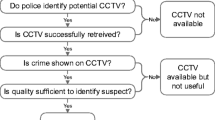Abstract
In a recent article in Res Publica, Jesper Ryberg argues that CCTV can be compared to a little old lady gazing out onto the street below. This article takes issue with the claim that government surveillance can be justified in this manner. Governments have powers and responsibilities that little old ladies lack. Even if CCTV is effective at preventing crime, there may be less intrusive ways of doing so. People have a variety of legitimate interests in privacy, and protection for these is important to their status as free and equal citizens. Consequently, though necessary, effectiveness is insufficient to justify CCTV in a democracy.
Similar content being viewed by others
Notes
All following in-text references are to page numbers in Ryberg (2007).
John Kleinig pointed this out to me.
I give this example because of a common law privacy case in America where a married woman sued for invasion of privacy because a doctor brought an assistant to her (home) birth without seeking her permission. For the full story see Allen and Mack (1991, p. 441).
For similar reasons, I object to the way Ryberg compares Mrs. Aremac and CCTV for the purposes of covert surveillance. Ryberg concludes that ‘Placed behind a window on the third floor, she clearly is an unobservable observer. But if she is not acting wrongly, then neither does the mere fact of CCTV surveillance being covert constitute a privacy rights problem’ (p. 134). However, ordinary people’s claims to secrecy are very different from those of public authorities, as we can see when we think about why citizens should be able to vote in secret, although in general their representatives should not. See Lever (2007a).
Ryberg seems to think that perverted or fetishistic gazing in and of itself does not violate privacy (p. 138). In other words, if two people see the same thing, and one is a voyeuristic pervert and the other is not, either both violate privacy or neither does, according to Ryberg. However, this seems unlikely if, as seems plausible, authorisation—or its lack—can matter to whether or not an act violates privacy. Assuming that people would object to being the object of voyeuristic scrutiny—as happens, for example, when spectators ‘rubber neck’ those who have been injured in a car crash—it is perfectly possible for two people to see the same thing, but one violates privacy and the other does not. However, the reasons to distinguish legal and moral wrongs seem relevant here, so attitude alone may be insufficient to turn an otherwise lawful act into a violation of legal rights to privacy, although it may prove decisive morally.
I am genuinely uncertain that CCTV does or must carry such a presumption, but whether or not it does is not settled, as Ryberg seems to believe, by one’s views on policemen plodding the beat (p. 138). It is important that policemen can help citizens to defend themselves and each other; CCTV cameras cannot. However, precisely for this reason, a police beat need not imply that citizens are mostly criminal. As CCTV seems to treat people solely as objects of scrutiny, it seems to raise worries that the police beat does not—although other forms of police surveillance may prove more problematic.
For those interested in the different ways searches and stops can be interpreted and justified, the following American Supreme Court cases might be helpful: Terry v. Ohio, 329 U.S. 1 (1968); Almeida-Sanchez v. United States., 413 U.S. 266 (1873); United States v. Brigoni-Ponce, 422 U.S. 873, (1975); United States v. Ortiz, 422 U.S. 891, (1975); United States v. Martinez-Fuerte, 428 U.S. 543 (1976); Delaware v. Prouse, 440 U.S. 648 (1979) and Brown v. Texas 443 U.S. 47 (1979).
For a discussion of absolute rights which I have found very helpful, see Waldron (1993, pp. 1–35).
This view of rights was developed most memorably by Raz (1986, pp. 165–186).
References
Allen, Anita, and Erin Mack. 1991. How privacy got its gender. Northern Illinois Law Review 10: 441–478.
Lever, Annabelle. 2000. Must privacy and equality conflict? A philosophical examination of some legal evidence. Social Research: An International Quarterly of the Social Sciences 67: 1137–1171.
Lever, Annabelle. 2005a. Why racial profiling is hard to justify: A response to Risse and Zeckhauser. Philosophy and Public Affairs 33: 94–110.
Lever, Annabelle. 2005b. Feminism, democracy and the right to privacy. Minerva: An Internet Journal of Philosophy 9: 1–31.
Lever, Annabelle. 2006. Privacy rights and democracy: A contradiction in terms? Contemporary Political Theory 5: 142–162.
Lever, Annabelle. 2007a. Mill and the secret ballot: Beyond coercion and corruption. Utilitas 20: 354–378.
Lever, Annabelle. 2007b. What’s wrong with racial profiling? Another look at the problem. Criminal Justice Ethics 26: 20–28.
Raz, Joseph. 1986. The morality of freedom. Oxford: Oxford University Press.
Ryberg, Jesper. 2007. Privacy rights, crime prevention, CCTV, and the life of Mrs. Aremac. Res Publica 13: 127–143.
Waldron, Jeremy. 1993. Liberal rights. Cambridge: Cambridge University Press.
Author information
Authors and Affiliations
Corresponding author
Rights and permissions
About this article
Cite this article
Lever, A. Mrs. Aremac and the Camera: A Response to Ryberg. Res Publica 14, 35–42 (2008). https://doi.org/10.1007/s11158-008-9044-4
Published:
Issue Date:
DOI: https://doi.org/10.1007/s11158-008-9044-4




